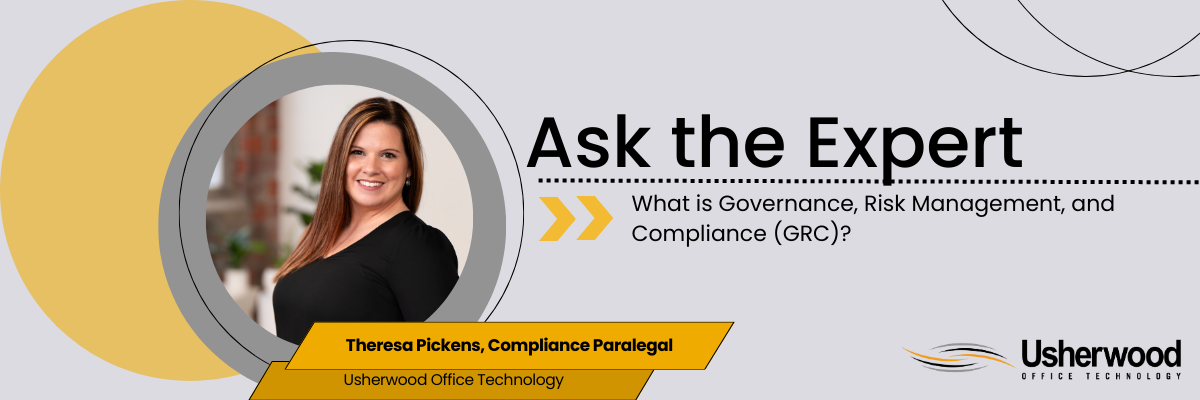By: Theresa Pickens on February 18th, 2025
Ask the Expert: What is Governance, Risk Management, and Compliance (GRC)?
As cyber threats grow in numbers and severity, regulatory bodies are developing new cybersecurity frameworks for businesses to adhere to. These frameworks vary by industry, and a new type of technology service has emerged as a result.
Often referred to as governance, risk management, and compliance, GRC is term broadly referring to the implementation of cybersecurity standards set forth by different governing institutions.
So what does this have to do with your business? You may already be tackling the details of becoming compliant and identifying the different frameworks that apply to your industry.
To simplify GRC and the involvement you'll need to have in compliance, here's an overview of what it might entail.
What is GRC as a Service?
GRC as a service (or GRCaaS) is when an IT provider or managed cybersecurity company offers guidance, tools, and support to businesses to help them become compliant.
Please note, it is your responsibility as a leader in your business to ensure compliance. GRCaaS companies simply offer GRC software for compliance management and guidance on implementing recommended changes.
An MSP will also help you make informed decisions about enterprise risk management. This may involve implementing practices to manage risk such as online compliance training for employees.
It's wise to ask your existing MSP about GRC services, which are also sometimes called Virtual Chief Information Security Officer (vCISO) services. This is because your network manager can directly configure the IT controls specified by any of your compliance frameworks.
Why is GRC Important?
GRC is a way for regulators to mandate basic protections that all businesses in that sector must have. This can prevent widespread cyber attacks that can affect entire industries at once.
For example, in 2024, an attack on CDK Global, a dealership software company, resulted in an estimated 2-7% hit in top-line revenue across the industry.
This is not a rare occurrence, either, cyber attacks can have devastating ripple effects for vendors who work and share data with each other.
Because of this interconnectedness, regulations play a critical role in safeguarding industries from widespread cyber disasters.
Major Types of Compliance Frameworks
There are several major types of frameworks often included in governance, risk, and compliance (GRC) software. A few of them include:
- PCI DSS - Finance
- NIST - Cyber risk management
- CMMC - Manufacturing
- ISO-2700- Information security
- SOC -2 - Information security
- HIPAA – protects health information
- NY DFS – Financial regulator
- FedRAMP – cybersecurity & risk management for U.S. federal agencies
Different GRC tools for risk management can help you become compliant. These platforms can help you track your compliance level by analyzing your cybersecurity processes, tools, documents, and policies in place.
There is a growing number of frameworks you may be on the hook for, and GRC software can even help you identify crossover to save time.
Compliance Trends to Watch in 2025
As cybersecurity evolves, so do regulatory frameworks. Some common trends experts are seeing include more structured risk management practices such as:
- Real-time network monitoring tools
- Penetration testing & cybersecurity audits
- Disaster recovery planning
- Effective vendor security management
These are common requirements that may affect your compliance status. Keep in mind - these details are your responsibility to address in your compliance activities. If you don't, you could face a major headache in the event of an attack and subsequent investigation.
How to Find Services to Become Compliant
If you're tasked with becoming compliant, you must take into account the exceptional organization, coordination, strategy, time, and cybersecurity tools needed. The good news is, there are many resources available to help businesses achieve compliance.
Consulting with a managed service provider that offers GRC as a service is a great place to start. Not only can they help you get set up with a GRC management tool to keep all of your documents and planning in one place - they can assist in implementing recommended tools.
A great first step is to meet with an MSP for a comprehensive cybersecurity audit. This will allow you to get a bird's-eye view of your network and any vulnerabilities that could jeopardize your compliance.
To learn more about getting a network assessment, click the button below to speak to a cybersecurity expert.
Read On

FFIEC to Retire Cybersecurity Tool - See What it Means For Financial Businesses
The Federal Financial Institutions Examination Council recently announced the retirement or...

How to Navigate Cybersecurity Compliance in NYS
With new standards, recommended tools, and expert advice surfacing constantly, cybersecurity can...

Is Microsoft Teams HIPAA Compliant?
Many healthcare providers have pivoted after the COVID-19 pandemic to offer telehealth services....
About Theresa Pickens
As Usherwood's Compliance Paralegal, Theresa supports internal GRC (Governance, Risk Management, and Compliance) initiatives, streamlining processes and enhancing our clients' confidence in the security of their technology.



